Odekon M. Encyclopedia of paleoclimatology and ancient environments
Подождите немного. Документ загружается.


Cross-references
Astronomical Theory of Climate Change
Carbon Cycle
Carbon Dioxide, Dissolved (Ocean)
Carbonate Compensation Depth
Coccoliths
Diatoms
Foraminifera
Iron and Climate Change
Paleo-Ocean pH
Phosphorus Cycle
Weathering and Climate
MARINE CLAY MINERALS
Clay minerals found in the marine environment may be arbitra-
rily divided into two genetic groups: those forming in and those
being transported into marine waters and sediments. Clay
minerals forming in seawater and sediments link directly to
diagenetic processes and are not examined in detail here. Detri-
tal clay minerals can be compared to source terrain or prove-
nance and hinterland climate, so are described here.
Clay minerals forming in the marine environment com-
monly display neoformational features, as they are often sec-
ondary to some precursor. Although this neoformation can
occur in the water column or within surficial sediments, this
is patently a diagenetic process with links to adjacent sea and
land surface conditions (such as paleoclimate) that are too ten-
uous for discussion here. Such links do exist; an example is
given by Worden et al. (2000). Early (near-surface) diagenetic
clay minerals include the group of clay minerals termed glauco-
nite, which may replace shells (e.g. foraminifera) or clastic
grains (e.g. feldspars). Deep burial diagenetic marine clay
minerals are beyond the scope of this description.
Clay minerals being transported into the marine environ-
ment are detrital in origin, being transported by water, ice,
air, or volcanic eruption. The types of clay minerals are thus
variable, depending on the source terrain lithology, weathering
characteristics during erosion and transport, transport time and
method, and final depositional environment. Thus, a granitic
source terrain will contain abundant feldspars; these may be
weathered in humid conditions to form kaolinite which will
be deposited close to shore as it flocculates and forms large
clay crystals. However, at any point in this story, our assump-
tions may be incorrect! In an arid environment, kaolinite pro-
duction will be diminished, even with the correct source
lithology (granite). Clays may be deposited as floodplain soils
where they become neoformed as successor clays during
temporary storage prior to a second phase of erosion and
marine deposition that will not reflect the hinterland litho-
logy. The moral of this story is that caution is required during
interpretation of both Recent and modern marine clay mineral
assemblages, as well as the more problematic ancient materials.
The mineral structure of clays is problematic (Parker and Rae,
1998). Since clays are layer silicates, often around 2 mm in size,
we are dependent on the Scanning Electron Microscope, Trans-
mission Electron Microscope, and X-ray diffractometer in per-
forming mineralogical analysis. This article follows the United
States Geological Survey convention (http:/ /pubs.usgs.gov/of/
of01-041/htmldocs/clay.htm) of listing “groups” of minerals
where appropriate, roughly by overall abundance, examining
the interpretation possibilities and problems in each case.
The abundant clay minerals of recent and ancient
marine sediments (in no particular order)
Chlorite group
The chlorites are Mg, Al, Fe aluminosilicates of the brittle mica
suite. They originate as hydrothermal minerals, but are most abun-
dant in chlorite schists and greenschist metamorphic terrains (their
most common provenance). Their occurrence in marine sediments
as detrital components reflects this primary source terrain as the
ultimate point of their origin and a clear association with physical
weathering (as opposed to chemical weathering and thus mineral
degradation). Rapid erosionby glaciers and rivers of mountain ter-
rains are the most common “first pass” interpretation proxy for the
chlorite group. The problems with chlorites stem from their wide-
spread occurrence and robust nature. Thus, they may survive more
than one cycle or erosion, being eroded out of their primary source
terrain, and subsequently deposited and stored in a secondary sedi-
mentary rock, before being re-eroded and deposited out of context
from their original source. Chlorites may also form during burial
diagenesis, thus potentially confusing any studies of paleo-
weathering or paleoclimates.
Illite. Illite comprises a K, Al alumino silicate of the mica
group. They originate as the weathering product of feldspars
and other clay minerals, especially the degradation of muscovite.
Illites may form hydrothermally in alkaline conditions rich in K,
often as an inter-layered mineral structure with smectites (‘mixed
layer illite-smectites’). Thus, they have a similar, if lower, meta-
morphic grade origin to chlorites. A very common component of
detrital marine sediments, illite is notable usually only by its
absence or abundance. A common interpretation strategy is to
consider illite as the ever-present “clay mineral rain” of the seas,
to be used as a ratio against smectite or kaolinite in paleoweather-
ing studies. The same interpretation problems pertain as with the
chlorite group: illite is robust and may survive many sediment
cycles; thus, its original provenance is rarely clear. The crystalli-
nity of illite is often maintained during erosion, reflecting the
metamorphic grade of the original hinterland.
Kaolinite group
The kaolinites comprise hydrous alumino silicates of the ser-
pentine-kaolin group. Their primary origin is associated with
the hydrothermal alteration of feldspars and other silicates.
Humid weathering also promotes similar degradation and the
kaolinization of feldspars is common under such climatic con-
ditions and is accelerated by warm, humid conditions. Volcanic
ashes often contain kaolinite. The kaolinites form one of the
most abundant and useful paleoclimate proxy materials as their
detrital presence always suggests humid conditions at some
point in their origin. Interpretation problems are also abundant
of course! A non-feldspar-bearing hinterland terrain may be
humid and warm, yet produce no kaolinite. As mentioned
above, kaolinite is also abundant and thus its presence is not
always enough to determine changing paleoclimatic conditions.
Ratios of kaolinite with other minerals have commonly been
employed in determining horizons of paleoclimate change.
Changing ratios, when compared favorably to other paleoclimate
proxies (stable isotopes, palynomorphs) form a useful method of
identifying episodes of past climate change (Chamley, 1989).
The tendency of kaolinite to flocculate and settle close to
shore thus means that changing ratios may also reflect variable
MARINE CLAY MINERALS 539

sea-levels, not changes in paleoweathering of the hinterland.
Finally, kaolinite is a common shallow burial diagenetic mineral.
Smectite group
The smectites are variable composition Ca, Na, Al, Mg Fe alu-
mino silicates for which montmorillonite is a practical syno-
nym. Smectites originate from the weathering of basic and
intermediate igneous and meta-igneous rocks, as well as being
a common constituent in volcanic ashes (bentonites, fuller’s
earths). As a result of weathering, soils forming in temperate
and humid climates, especially where seasonally wet, com-
monly contain smectite. Thus, their proxy interpretation is
similar to that of the kaolinites, if not quite as clear. Problems
in interpreting the presence and changing abundance of smec-
tites in rock successions include the inverse problem to kaoli-
nite: commonly being a small crystal, smectite tends to stay
buoyant for longer than other clays and thus is deposited off-
shore. For this reason, it has been associated with deep marine
and transgressive conditions – the paleoclimate “signal” in its
abundance may be masked by relative sea-level changes. An
even greater hazard to smectite interpretation is its volcanic ori-
gin, as ash-falls can appear randomly in the sedimentary
record, masking any paleoclimatic control. Detailed petro-
graphic investigation of the presence of volcanic glass shards
or ash-fall textures may resolve this interpretation hazard.
Mixed-layer clays. Many of the clay mineral crystal groups
listed above and below can become interstratified. Most com-
mon are the illite-smectites and chlorite-smectites. Such clays
often have a hydrothermal origin. In soils, they form when con-
ditions are episodic, such as wetting and drying cycles. Thus,
the presence of mixed-layer illite-smectites has been related
to seasonal climates. Interpretation is hazardous, however, as
these minerals are difficult to characterize.
The less abundant clay minerals of recent and ancient
marine sediments (in no order)
For the sake of brevity, I have selected two of the many tens of
rarer clay minerals to demonstrate their use in paleoclimatic
interpretations.
Sepiolite and palygorskite
Sepiolite is part of the palygorskite group and possesses a Mg-
bearing, hydroxide chain-like silicate structure. Palygorskite is
chemically and structurally more complex. Both are of use to
paleoclimatologists, especially palygorskite as it forms in
near-surface arid conditions. If proven to be detrital and found
in marine sediments, an arid hinterland can be assumed. The
problem is its rarity and actual provenance as wind-blown dust
may be transported in the stratosphere from arid zones to those
of a humid nature, confusing the interpretation.
Alastair Ruffell
Bibliography
Chamley, H., 1989. Clay Sedimentology. Berlin: Springer, 349pp.
Parker, A., Rae, J.E. (eds.), 1998. Environmental Interactions of Clays:
Clays and the Environment. Berlin: Springer/ GmbH & Co. KG; 210pp.
Worden, R.H., Ruffell, A.H., and Cornford, C., 2000. Surface temperature,
sequence stratigraphy and deep burial diagenesis. Clay Miner., 35,
13–23.
Cross-reference
Mineral Indicators of Past Climates
MARS: WATER AND PAST CLIMATES
Mars has long been the focus of a great deal of attention,
largely due to the presence of water and the potential for har-
boring life, either now or in the past. Until recently the question
of life on Mars has focused on whether Mars was once “ warm
and wet” and Earthlike or “cold and dry” and barren like the
Moon. The recent orbiter and rover missions have revealed that
Mars is a remarkably diverse place and these simple labels no
longer fit. Mars has experienced a striking diversity of environ-
ments from extremely arid deserts, to standing water in lakes,
to a planet blanketed by snow and ice. The key questions in
the search for life have therefore become how warm, how
wet, and most importantly, for how long?
The evidence for these past environments is contained in
the rocks, minerals, and landforms of Mars. Minerals in parti-
cular contain the record of geologic processes and ancient
environments in which they formed; certain minerals only
form in water, whereas others are rapidly destroyed in wet
environments.
Mars is a volcanic planet
The first close-up images of Mars revealed a surface dotted
with massive volcanoes and provided the first hints of a planet
dominated by volcanic processes (Figure M9). However, the
definitive information on the composition of Martian rocks
has come from the visible, infrared, neutron, and gamma ray
spectrometers that have been used to map mineral and elemen-
tal compositions. Spectral data from Earth-based telescopes
and early spacecraft missions provided hints of composi-
tional differences and the presence of iron-bearing minerals
(e.g., Soderblom, 1992). The first global maps of the minerals,
rocks, and ice on the surface, as well as the dust and conden-
sates in the atmosphere of Mars were made using data from
the Thermal Emission Spectrometer (TES) infrared spectro-
meter aboard the Mars Global Surveyor (MGS) spacecraft
(e.g., Christensen et al., 2001). These observations have been
followed up by near-IR spectra from the Mars Express
OMEGA experiment (Mustard et al., 2005).
TES infrared spectra have shown that the rocks and sands are
composed almost entirely of volcanic minerals characteristic of
basaltic rocks (e.g., Christensen et al., 2001). These common
minerals– feldspar, pyroxene, and olivine – are found in the basal-
tic lavas that also cover much of the Earth, from the ocean floor
to the volcanic islands of Hawaii and Iceland. OMEGA has con-
firmed the widespread occurrence of olivine and pyroxene
over much of the surface (Mustard et al., 2005). The rocks in the
ancient cratered terrains are basaltic in composition, whereas
the younger rocks of northern lowlands have more glass, more
silica-rich minerals, and fewer iron-bearing pyroxene and olivine
minerals (Christensen, 2001; Mustard, 2005). Volcanic rocks
high in silica typically form by complex processes that include
remelting of existing basalts, fractional crystallization, or melting
of a water-rich source region. The possible existence of higher-
silica rocks on Mars may imply more water in the mantle than
on Earth, or differing temperatures or pressures at which melting
occurred. Alternatively, the high-silica components may have
been produced by minor aqueous weathering of basalt (e.g., Wyatt
et al., 2004). In either case, the vast majority of the Martian rocks
is volcanic in origin.
540 MARS: WATER AND PAST CLIMATES
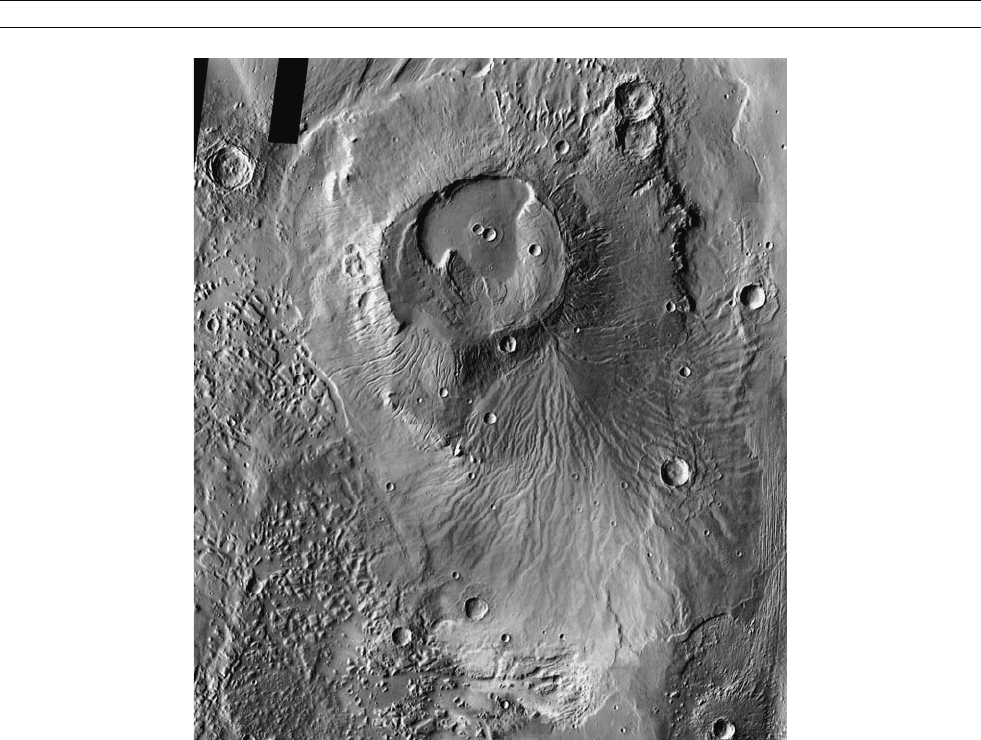
Early fluvial activity
Many of the ancient, heavily-cratered terrains of Mars contain
channels that were eroded by water. Analysis of the global distri-
bution of these channels has shown that extensive fluvial activity
occurred over portions of the ancient highlands (Figure M10).
These data indicate a period of erosion early in Mars history that
produced extensive infilling of craters, the development of local
and regionally integrated drainage networks, and the formation
of deltas and alluvial fan deposits (e.g., Gulick and Baker, 1989;
Malin and Edgett, 2003;Howardetal.,2005). The development
of these drainage networks and depositional fans is suggestive of
runoff from precipitation or rapid melting of snow, possibly aided
by groundwater sapping. It has also been suggested that Mars
had extensive oceans on the basis of images and topographic
data that suggest shorelines, smooth ocean floors, and glacial
eatures (Baker et al., 1991).
The prevailing environment during the early period of flu-
vial erosion may have been one of a cold, thin atmosphere with
very limited mechanical erosion, punctuated by short periods of
thicker atmosphere and greater erosion. These thicker atmo-
spheres may have been produced by periodic climate changes
(e.g., Pollack and Toon, 1982 ), or generated in the impact cra-
tering process and lasting hundreds to thousands of years
(Segura et al., 2002). Fluvial erosion appears to have reached
a climax in the late Noachian period (3–3.5 Gyr) (Howard
et al., 2005), with only limited activity since that time that
is primarily associated with large catastrophic flood events, iso-
lated channel formation, and minor incision of small gullies
(Malin and Edgett, 2000).
A cold, dry Mars
Although there is strong evidence for early fluvial activity in iso-
lated locations, the global mineral mapping shows an ancient,
cratered surface whose original volcanic minerals are still largely
preserved, implying very little alteration by water. Olivine and
pyroxene form at very high temperatures (>800
C), but are
unstable in the presence of water at the surface as on Earth
today. However, ancient pyroxene- and olivine-rich basalts
are common; they are exposed more than 4.5 km below the sur-
face in the walls of Valles Marineris and throughout the equa-
torial plains (Hoefen et al., 2003; Hamilton and Christensen,
2005; Mustard et al., 2005). Near the summit of Syrtis Major
are a series of old, volcanic cones and flows composed of
glassy lavas (Christensen et al., 2005) that are also highly sus-
ceptible to chemical erosion. The occurrence of these unstable
minerals suggests that neither sub-surface hydrothermal activ-
ity nor surface aqueous weathering has significantly affected
these very old rocks since they were emplaced.
Figure M9 Apollinaris Patera, a 200 km wide ancient volcano, is seen in this mosaic of THEMIS infrared images. Apollinaris erupted huge volumes
of ash that have been carved into channels by water.
MARS: WATER AND PAST CLIMATES 541
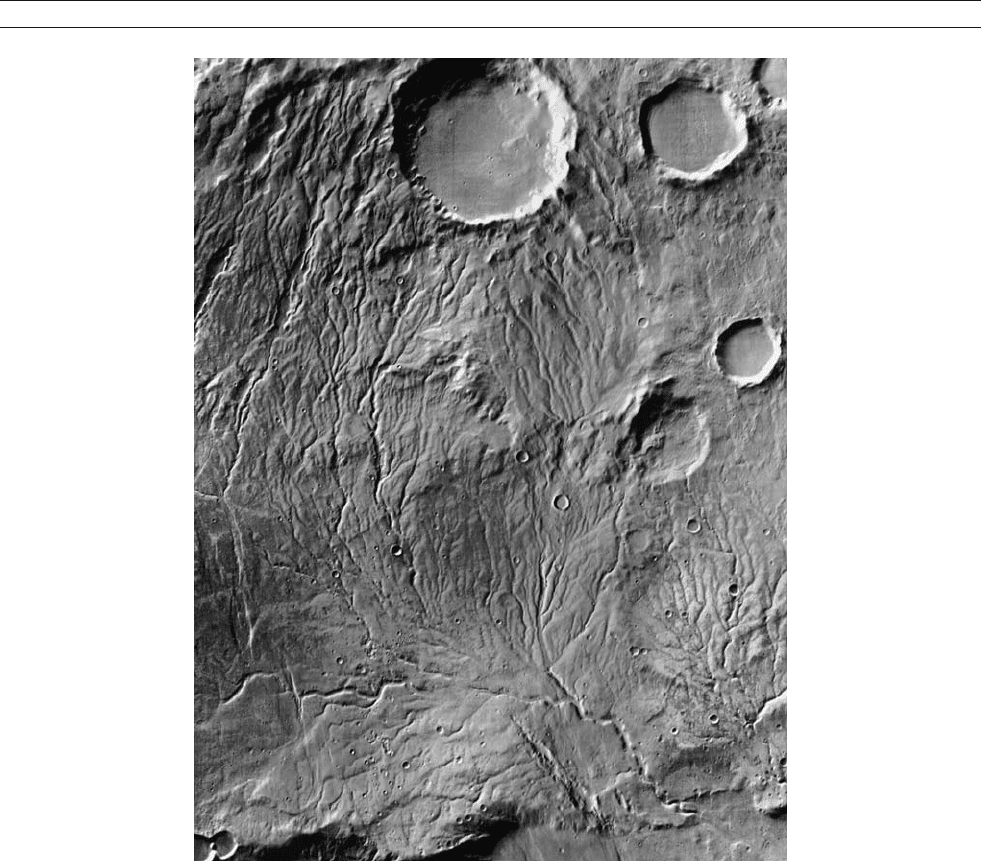
The Spirit rover at Gusev Crater has provided additional
mineralogical evidence for limited aqueous weathering. The
rocks on the crater floor are volcanic and extremely old, per-
haps as much as 3 billion years, yet the Mini-TES, Mössbauer,
and Alpha Particle X-ray spectrometer (APXS) spectrometers
and cameras on the rover clearly show the presence of oli-
vine and pyroxene that have been very little altered since
these lavas first cooled (McSween et al., 2004). These pristine
volcanic rocks provide evidence that these plains have not
been exposed to any significant amount of water since these
lavas were erupted. They may have been “wetted, ” as evi-
denced by thin coatings on some rocks, but they have not been
“soaked.”
What is not found
In assessing the climate history of Mars, it is important to
consider what rock types are not present. On Earth, vast deposits
of carbonate rocks, composed of CO
3
2–
with calcium, magnesium,
or iron, have precipitated from warm oceans through interactions
between CO
2
gas, water, and mineral grains. If Mars ever had a
warm ocean, it has been suggested that thick deposits
of carbonates would have also formed through interactions
with its CO
2
atmosphere. Spectra from TES and the Mini-
TES on the Mars Exploration Rovers have shown that small
amounts of carbonate are present in the ubiquitous Martian dust
(Bandfield et al., 2003). These minerals most likely formed by
direct interaction with water vapor in the atmosphere. However,
no evidence of extensive carbonate rock layers has been found
by the TES, THEMIS, or OMEGA instruments (Christensen
et al., 2001; Bibring et al., 2005), suggesting that if Mars ever
had oceans, they were either too cold, too short-lived, were
covered by ice that limited interactions with the atmosphere,
or had unique chemical conditions that prevented carbonates
from forming. Clay minerals, which form primarily by aqueous
weathering and are common on Earth, have also been shown
by OMEGA and TES to be rare on Mars (Christensen et al.,
Figure M10 Evidence of fluvial processes early in Martian history is illustrated in the drainage network of Warrego Valles. This image is a mosaic
of THEMIS daytime infrared images covering an area 200 km wide centered near 42
S, 266
E.
542 MARS: WATER AND PAST CLIMATES
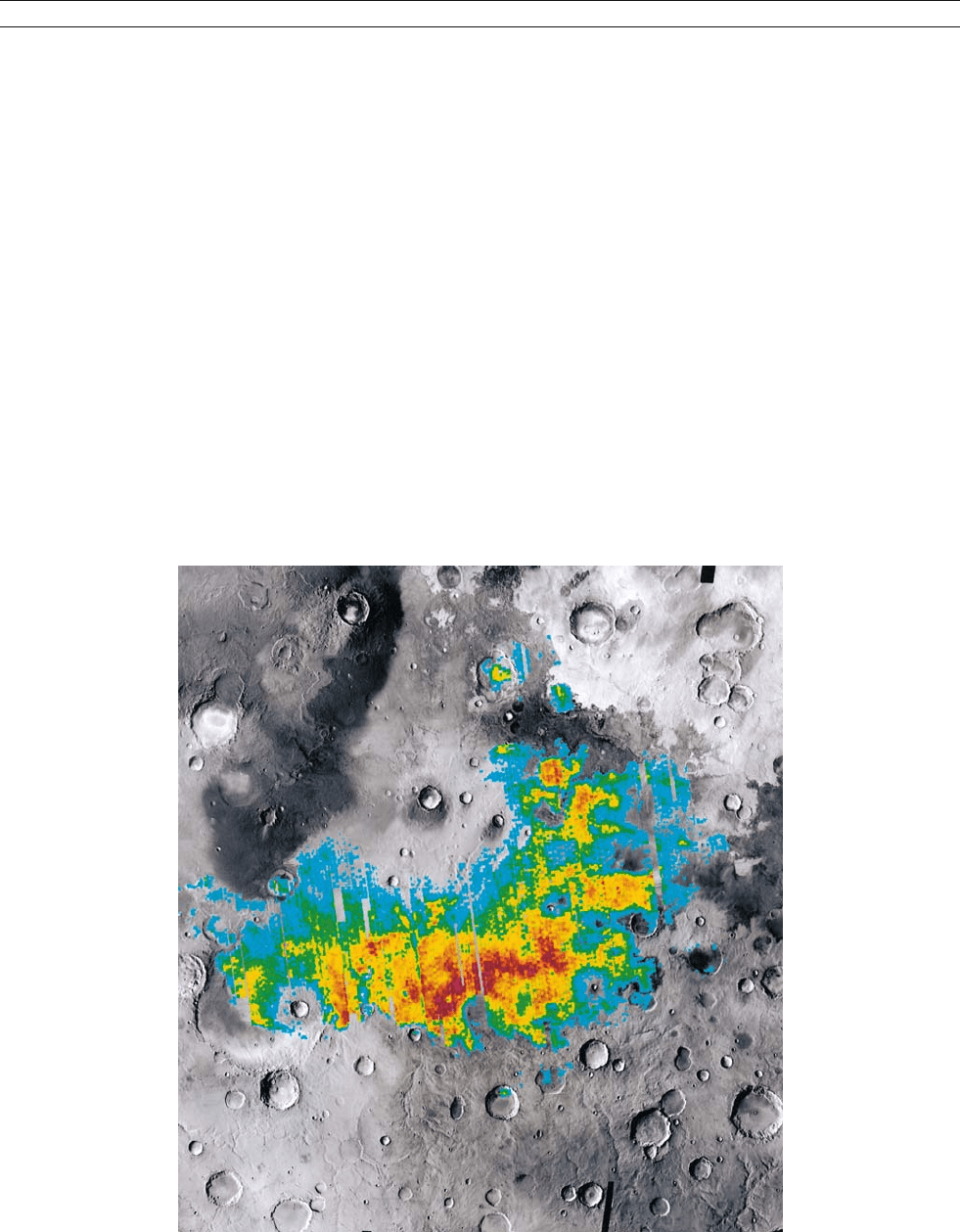
2001; Bibring et al., 2005), again suggesting that Mars has
experienced little aqueous alteration.
While lakes and drainage networks clearly point to fluvial
processes, the lack of extensive carbonates and clays, together
with the presence of original olivine, pyroxene, and glass,
argue that these processes must have been relatively short-
lived. Thus, on a global scale, aqueous chemical weathering
appears to have been a relatively minor process throughout
much of Martian history.
Meridiani – a locally wet Mars
The Meridiani Planum site explored by the Opportunity rover
was chosen based on spectral evidence from the TES for
high abundances of crystalline hematite, an iron oxide that
forms by several processes, most of which involve water
(e.g., Christensen and Ruff, 2004)(Figure M11). Hematite
can form by precipitation from fluids circulating through
saturated sediments or by deposition of precursor water-bearing
iron minerals that are dehydrated over time. The mineralogic
evidence for water at Meridiani is corroborated by the unique
appearance of the hematite-rich surface in Meridiani indicative
of water deposition: the Meridiani rocks are finely layered and
easily eroded, suggesting a sedimentary deposit; they sit atop
an older, heavily cratered surface, implying a different process
of formation; and they embay pre-existing channels, suggesting
that these rocks were deposited in water rather than cover-
ing the entire landscape as volcanic ash or windblown dust
(Christensen and Ruff, 2004).
Upon landing, Opportunity’s spectrometers and cameras
confirmed the importance of water at Meridiani (Squyres et al.,
2004). Outcrops of layered sedimentary rocks were observed
by Opportunity’s cameras, and the Mössbauer, APXS, and
Mini-TES spectrometers found that these rocks contained high
(30–40%) abundances of sulfates most likely formed by eva-
poration of sulfur-rich water. The hematite occurs as 1–5mm
diameter spheres that are embedded within the rock layers,
and were likely formed by iron-rich fluids circulating through
the lake sediments (e.g., Squyres et al., 2004). The margins
of this body of water may not have extended much beyond
the current deposits of hematite seen from orbit, making this
a large lake (Christensen and Ruff, 2004), rather than part of
a global ocean. Several nearby craters also have hematite-rich
layered rocks, suggesting they may have held separate lakes
(Christensen and Ruff, 2004).
The coarsely-layered rocks exposed at the base of Burns
Cliff in Endurance Crater appear to have been formed by
migrating dunes, whereas the layers at the top of the cliff are
made of sulfate-rich sediments deposited in water (Grotzinger
Figure M11 The distribution of crystalline hematite discovered by TES in Meridiani Planum. The TES hematite abundances are shown
superimposed over a mosaic of THEMIS daytime infrared images illustrating the complex morphology of the Meridiani region.
MARS: WATER AND PAST CLIMATES 543
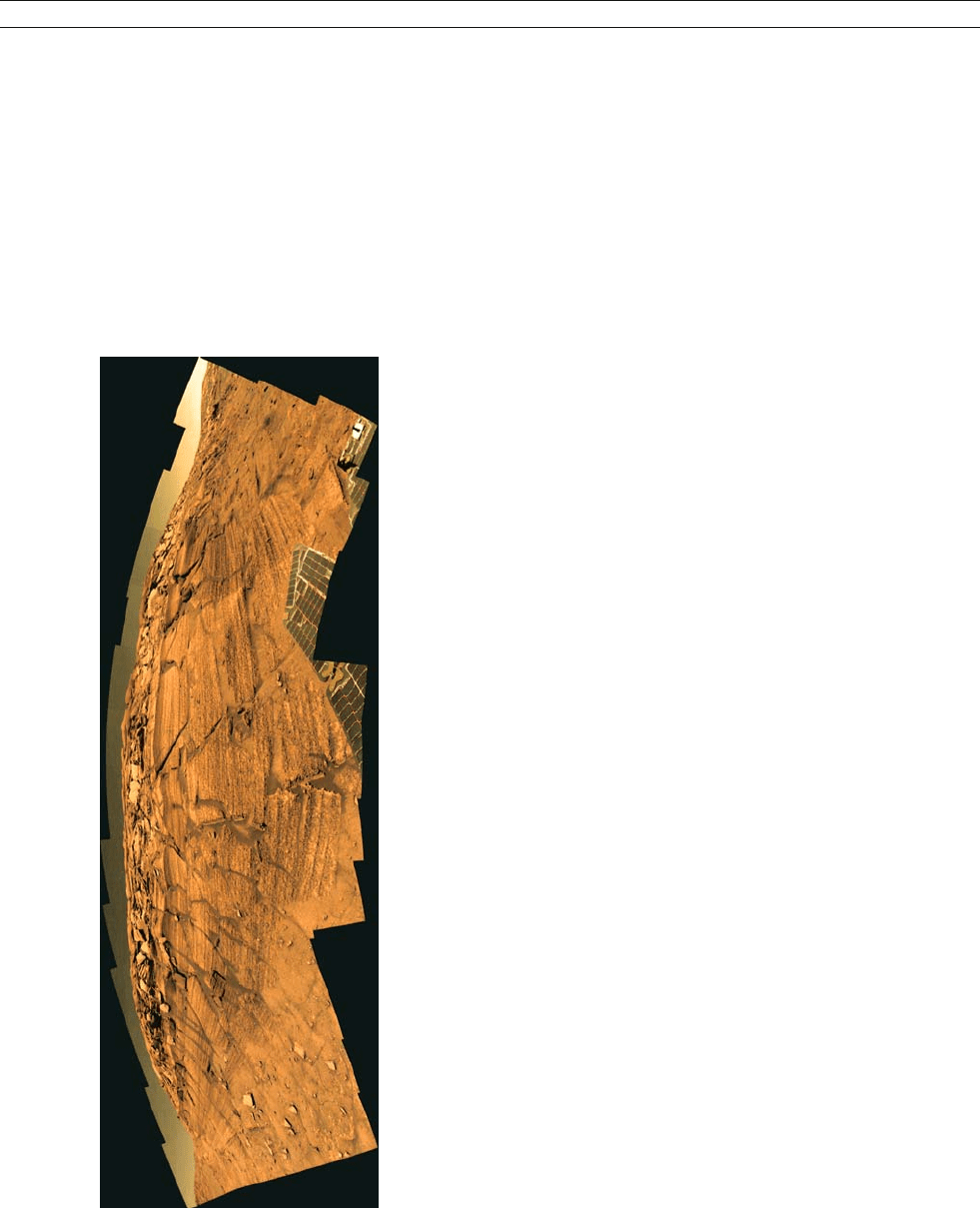
et al., 2005) (Figure M12). These layers may record variations
in climate from arid eolian dunes, to wet evaporating playas
where the sulfate salts were formed, to a groundwater system
that formed the hematite spheres (Grotzinger et al., 2005). This
system may have persisted for thousands of years.
Evidence for standing water is also seen at Aram Chaos, a
300-km diameter crater basin that is filled with layered rocks
that contain both hematite and sulfate and show evidence for
a lake created by the release of massive amounts of sub-surface
water (Glotch and Christensen, 2005; Gendrin et al., 2005).
Finely-layered erodable rocks that contain hematite and sulfate
are also found in the troughs of Valles Marineris, suggesting
that they also were deposited in standing water.
These discoveries provide strong evidence that water was
stable in isolated regions for brief periods of time. The factors
that caused water to accumulate and allowed it to remain at
these sites (perhaps a combination of heat from sub-surface
volcanic activity, high salt concentrations that lowered the
freezing temperature, or a protective covering of ice over water
released by catastrophic floods) are currently unknown.
Modern snow and ice
There is growing evidence that Mars has a large inventory of
water, currently in the form of ice at mid- to high-latitudes. Both
poles have deposits of ice or ice-rich sediments that are up to three
km thick and cover morethan500,000km
2
. Temperature measure-
ments have demonstrated that the perennial north polar cap was
water ice, whereas a layer of CO
2
ice remains over much of the
south polar cap even through the summer (Kieffer, 1979). Recent
measurements by the MOC, THEMIS, and OMEGA instruments
have shown that windows of water ice are exposed within the
south polar cap, indicating that water ice is present there beneath
a thin layer of overlying CO
2
ice (Byrne and Ingersoll, 2003;Titus
et al., 2003; Langevin et al., 2004).
A substantial inventory of water ice was discovered using
data from the Gamma Ray Spectrometer (GRS) and the
High Energy Neutron Detector (HEND) instruments on Mars
Odyssey (Feldman et al., 2002). The regions poleward of
60
in both hemispheres are made up of more than 80%
water ice (Figure M13). Such high ice abundances could not
have formed by diffusion of water vapor from the atmosphere
into the pores of the soil. Ice must have been deposited as a
layer of snow or frost.
These ice deposits are reservoirs of water that can migrate
as the climate changes. The Martian climate is predicted to
change dramatically as the tilt of the Martian spin axis oscil-
lates by as much as 20
on timescales of 10
5
–10
6
years (Ward,
1974). These changes likely produce a significant mobilization
of polar water, redistributing it to lower latitudes as snow and
ice (e.g., Jakosky and Carr, 1985). When the axis is oriented
more perpendicular to the Sun (low obliquity), the poles are
the coldest places on the planet and water migrates to them.
As the axis tilts toward the Sun (high obliquity) the poles
warm, the mid-latitudes cool, and water, in the form of snow
and ice, migrates to the mid-latitudes. Remnants of these ice
deposits can be found in unusual landforms throughout the
mid-latitudes. One type is a “basketball ” textured terrain that
only occurs between 30
and 50
latitude in both hemispheres
and was suggested to have formed as soils cemented by ice
deposited during the last “ice age’’ lost their ice and eroded
as the climate warmed (Mustard et al., 2001).
A second type of deposit occurs preferentially on cold, pole-
facing slopes (Carr, 2001). These “ pasted on” slope mantles are
up to 10 m thick, often occur in hollows, and can have features
suggestive of flow (Figure M14). These characteristics suggest
an ice-rich layer that was once more extensive but has been
removed from all but the coldest, pole-facing slopes.
One of the more remarkable discoveries made by the MGS
MOC camera is the small young gullies that also occur
between 30
and 50
latitude in both hemispheres (Malin
and Edgett, 2000)(Figure M14). These gullies have been pro-
posed to form from discharge of liquid water from sub-surface
aquifers, the rapid release of liquid CO
2
, dry landslides, the
melting of ground ice that percolates to an impermeable
layer, the melting of pore ice that diffused inward from the
atmosphere during periods of colder temperatures, or through
Figure M12 Burns Cliff, Endurance Crater. After descending into
Endurance Crater, the Spirit rover drove to Burns Cliff, a spectacular
rock outcrop 7 m high made of finely-layered rock. These layers are
composed of basaltic sands and evaporite minerals that were
deposited in a varying environment of wind and water.
544 MARS: WATER AND PAST CLIMATES
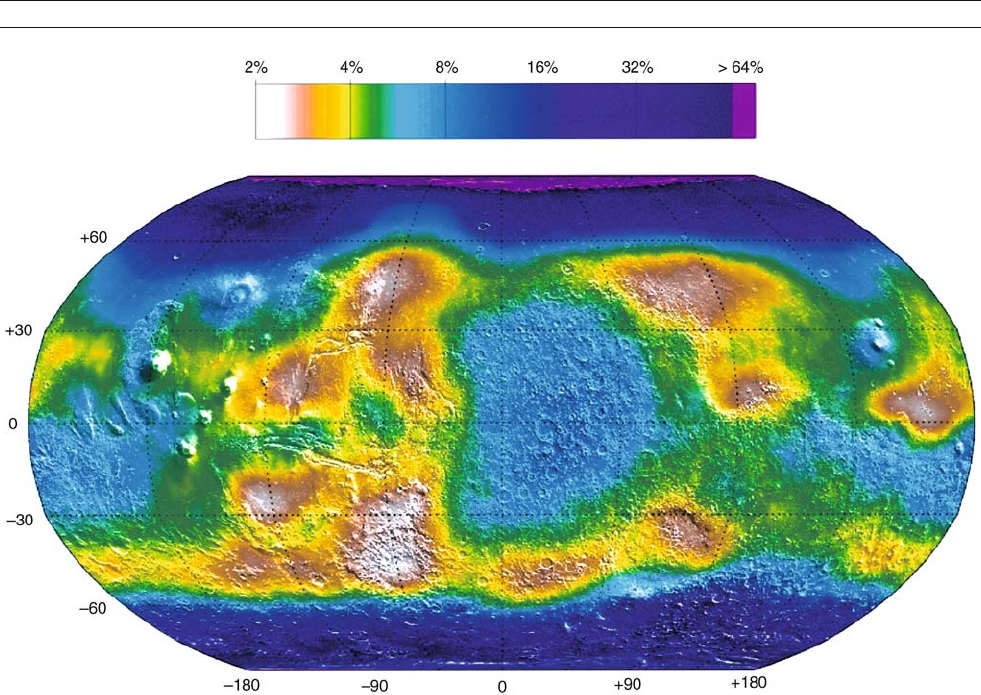
melting of a snow layer deposited during periods of higher
obliquity when surface ice was stable at these latitudes (see
recent review by Heldmann and Mellon, 2004).
The proposed melting of pore ice does not account for the
fact that as the surface and sub-surface temperatures warm,
the upper soil layer will become desiccated before significant
liquid water can be produced (Mellon and Phillips, 2001).
Water release from sub-aquifers can explain gully morphology,
latitudinal distribution, and slope position (Heldmann and
Mellon, 2004). The primary arguments against this model are
the presence of gullies on isolated knobs and dunes with no
obvious aquifer source. An aquifer source is a survival and
recharge mechanism that would allow these aquifers to persist to
the present, their formation only at latitudes poleward of 30
,
and the ability of water to remain liquid long enough to carve gul-
lies up to 2 km long under current atmospheric conditions.
In the snowmelt model (Lee et al., 2001; Christensen, 2003),
the snow acts as a greenhouse, absorbing sunlight beneath the sur-
face, but preventing the heat from being re-radiated (Clow, 1987).
This layer of snow also acts as an insulating layer that limits
evaporation of the melted water. As a result, snow can melt
10–20 cm beneath the surface and remain liquid, even when the
surface temperatures are far below freezing (Clow, 1987). In this
model (Christensen, 2003), a layer of snow is deposited at mid-
latitudes during periods of high obliquity. As the obliquity
decreases and the mid-latitude climate warms, the snow melts
and erodes gullies in the snow and underlying surface. Eventually
most of the snow completely melts, revealing gullies carved in the
hillsides. Patches of snow remain today as “pasted on” deposits
where they are protected against sublimation by a layer of desic-
cated dust/sediment. Melting could be occurring at the present
time in favorable locations in these snowpacks, and these patches
may provide fascinating locales in which to search for life, if it
exists (Christensen, 2003).
Summary – and where to look next
The new tools that have permitted a more detailed view of
Mars from orbit and the surface have shown that Mars is
remarkably diverse. The role of water has varied tremendously
at different times and in different places on Mars. There is no
doubt that Mars experienced periods of channel formation early
in its history, yet those ancient rocks contain minerals that
quickly break down in a wet environment, and also lack exten-
sive clays and carbonates. The current climate is very dry and
cold, yet the Opportunity rover landed on the floor of an
ancient body of water. Finally, liquid water is not stable at
the surface today, yet recent gullies emerge from modern aqui-
fers or beneath modern snowpacks.
How can these apparently conflicting views be reconciled?
One possibility is that the erosional periods were too brief for
extensive chemical weathering to have occurred – mechanical
erosion of channels can proceed much more rapidly than
Figure M13 The distribution of sub-surface water ice. This global map was made using data from the Neutron Spectrometer that is part of
the Odyssey Gamma Ray Spectrometer suite. Hydrogen in the form of water ice occurs in abundances >80% poleward of 60
in both
hemispheres (data are adapted from Feldman et al., 2002).
MARS: WATER AND PAST CLIMATES 545
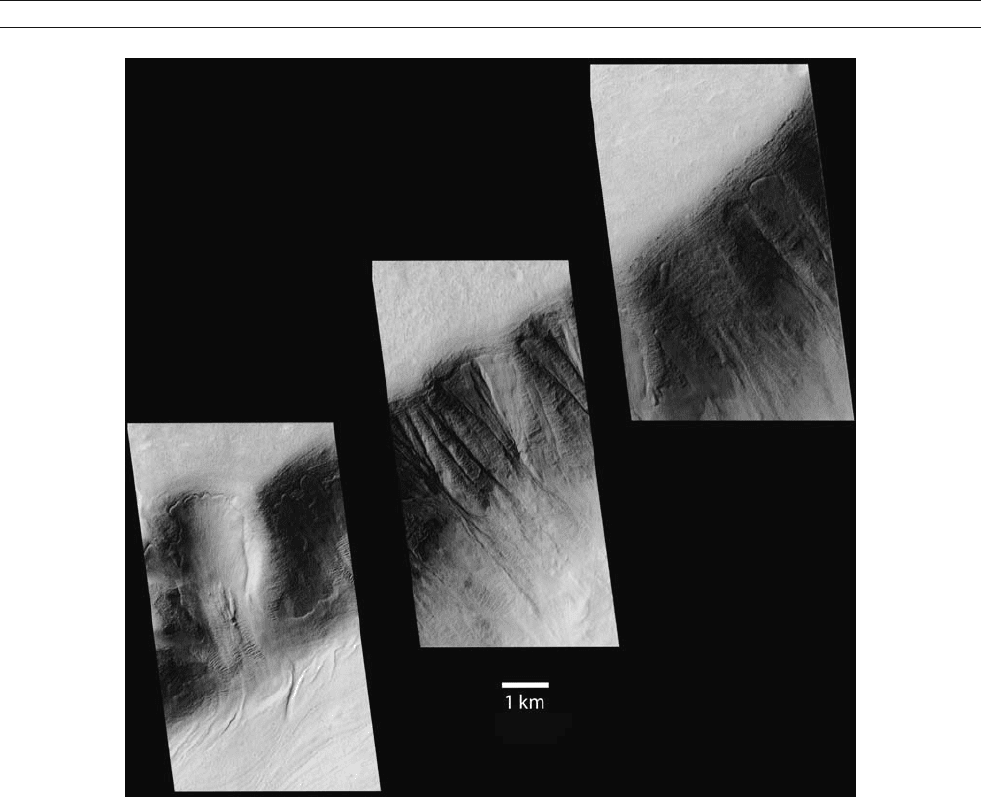
chemical weathering. The erosional periods may have been
caused by large impacts that produced very short-lived, thick
atmospheres that allowed liquid water to persist (Segura et al.,
2002). Thus, while Mars possesses a large inventory of water, it
is likely that this water has remained frozen throughout much
of its history, resulting in very little chemical weathering. Spor-
adically this water is released to form channels and lakes.
While neither typical nor common, the locations where liquid
water may have been present for long periods of time – ancient
lakes and modern snows – nonetheless hold the greatest promise
for future exploration. In the modern gully systems, liquid
water likely occurs very near the surface, is stable for extended
periods of time, and is regenerated on the relatively short time-
scales associated with climate oscillations. Repeated access to
near-surface liquid water could provide a means for life to
have survived over extended periods of Martian history, and could
provide favorable sites for past or present life. Finally, the great
diversity of surface environments from place to place and through
time on Mars is a sign of a complex climate history. It is also is
one of the most hopeful indicators for the possibility of Martian
life, providing a rich suite of environments where life may have
taken hold.
Phillip R. Christensen
Bibliography
Baker, V.R., Strom, R.G., Gulick, V.C., Kargel, J.S., Komatsu, G., and
Kale, V.S., 1991. Ancient oceans, ice sheets, and the hydrological cycle
on Mars. Nature, 352, 589–862.
Bandfield, J.L., Glotch, T.D., and Christensen, P.R., 2003. Spectroscopic
identification of carbonates in the Martian dust. Science, 301,
1084–1087.
Bibring, J.-P., Langevin, Y., Gendrin, A., Gondet, B., Poulet, F., Berthé, M.,
Soufflot, A., Arvidson, R., Mangold, N., Mustard, J., Drossart, P.,
and Omega-Team, 2005. Mars surface diversity as revealed by the
OMEGA/ Mars Express Observations. Science, 307, 1576–1581,
doi:10.1126/ science.1108806.
Figure M14 Ice-rich mantles and associated gullies on poleward facing slopes in the Southern Hemisphere. This collage shows MOC images from
the northwest wall of Dao Valles, between 33
and 35
S. These images show well developed flow features with compressive ridges that are
strongly suggestive of ice (left panel), mantles of ice-rich material with gullies that are only present where the mantles are lacking (center panel),
and depressions with associated gullies, some of which still have mantles, whereas others are free of mantling material (right panel). These
landforms could be explained by the melting of a snow mantle to form gullies, which are only visible in those locations where the snow has
completely disappeared. MOC images left to right: M03-04950, M09-02885, and M0-3-6266.
546 MARS: WATER AND PAST CLIMATES

Byrne, S., and Ingersoll, A.P., 2003. A sublimation model for Martian
south polar ice features. Science, 299, 1051–1053.
Carr, M.H., 2001. Mars global surveyor observations of fretted terrain.
J. Geophys. Res., 106, 23571–23595.
Christensen, P.R., 2003. Formation of recent Martian gullies through
melting of extensive water-rich snow deposits. Nature, 422,45–48,
doi:10.1038/ nature01436.
Christensen, P.R., and Ruff, S.W., 2004. The formation of the hematite-
bearing unit in Meridiani Planum: Evidence for deposition in standing
water. J. Geophys. Res., 109, E08003, doi:10.1029/ 2003JE002233.
Christensen, P.R., Bandfield, J.L., Hamilton, V.E., Ruff, S.W., Kieffer, H.
H., Titus, T., Malin, M.C., Morris, R.V., Lane, M.D., Clark, R.N.,
Jakosky, B.M., Mellon, M.T., Pearl, J.C., Conrath, B.J., Smith, M.D.,
Clancy, R.T., Kuzmin, R.O., Roush, T., Mehall, G.L., Gorelick, N.,
Bender, K., Murray, K., Dason, S., Greene, E., Silverman, S.H., and
Greenfield, M., 2001. The Mars Global Surveyor Thermal Emission
Spectrometer experiment: Investigation description and surface science
results. J. Geophys. Res., 106, 23823–23871.
Christe nsen, P.R., McSween, H.Y. Jr., Bandfield, J.L., Ruff, S.W.,
Rogers, A.D., Hamilton, V.E., Gorelick, N., Wyatt, M.B., Jakosky,
B.M., Kieffer, H.H., Malin, M.C., and Moersch, J.E., 2005.
Evid ence for igneous diversity and magmatic evolution on Mars
from infrared spectral observations, Nature, 436, doi:10.1038 /
nature03639.
Clow, G.D., 1987. Generation of liquid water on Mars through the melting
of a dusty snowpack. Icarus, 72,95–127.
Feldman, W.C., Boynton, W.V., Tokar, R.L., Prettyman, T.H., Gasnault, O.,
Squyres, S.W., Elphic, R.C., Lawrence, D.J., Lawson, S.L., Maurice, S.,
McKinney, G.W., Moore, K.R., and Reedy, R.C., 2002. Global distri-
bution of neutrons from Mars: Results from Mars Odyssey. Science,
297,75–78.
Gendrin, A., Mangold, N., Bibring, J.-P., Langevin, Y., Gondet, B.,
Poulet, F., Bonello, G., Quantin, C., Mustard, J., Arvidson, R., and
LeMouelic, S., 2005. Sulfates in Martian layered terrains: The
OMEGA/ Mars Express view. Science, 307, 1587–1590.
Glotch, T.D., and Christensen, P.R., 2005. Geologic and mineralogic
mapping of Aram Chaos: Evidence for a water-rich history. J. Geophys.
Res., 110, E09006, doi:10.1029/ 2004JE2389.
Grotzinger, J., Bell, J.F. III., Calvin, W., Clark, B.C., Fike, D.,
Golombek, M., Greeley, R., Herkenhoff, K.E., Jolliff, B., Knoll, A.H.,
Malin, M., McLennan, S.M., Parker, T., Soderblom, L., Sohl-Dickstein,
J.N., Squyres, S.W., Tosca, N.J., and Watters, W., 2005. Stratigraphy,
sedimentology and depositional environment of the Burns Formation,
Meridiani Planum, Mars. Earth Planet. Sci. Lett., 240,14–75.
Gulick, V.C., and Baker, V.R., 1989. Fluvial valleys and Martian palaeo-
climates. Nature, 341, 514–516.
Hamilton, V.E., and Christensen, P.R., 2005. Evidence for extensive
olivine-rich bedrock in Nili Fossae, Mars. Geology, 33, 433–436.
Heldmann, J.L., and Mellon, M.T., 2004. Observations of Martian gullies
and constraints on potential formation mechanisms. Icarus, 168,
285–304.
Hoefen, T., Clark, R.N., Bandfield, J.L., Smith, M.D., Pearl, J.C., and
Christensen, P.R., 2003. Discovery of olivine in the Nili Fossae region
of Mars. Science, 302, 627–630.
Howard, A.D., Moore, J.M., and Irwin, R.P. III., 2005. An intense terminal
epoch of widespread fluvial activity on early Mars: 1. Valley network
incision and associated deposits. J. Geophys. Res., 110, E12S14,
doi:10.1029/ 2005JE002459.
Jakosky, B.M., and Carr, M.A., 1985. Possible precipitation of ice at low
latitudes of Mars during periods of high obliquity. Nature, 315,
559–561.
Kieffer, H.H., 1979. Mars south polar spring and summer temperatures:
A residual CO
2
frost. J. Geophys. Res., 84, 8263–8289.
Langevin, Y., Poulet, F., Gendrin, A., Gondet, B., Berthé, M., Soufflot, A.,
Drossart, P., Combes, M., Bellucci, G., Moroz, V., Mangold, N.,
Schmitt, B., and Omega-Team, 2004. Perennial water ice identified in
the south polar cap of Mars. Nature, 428, 627–630.
Lee, P., Cockell, C.S., Marinova, M.M., McKay, C.P., and Rice, J.W., 2001.
Snow and ice melt flow features in Devon Island, Nunavut, Arctic
Canada as possible analogs for recent slope flow features on Mars, in
Proceedings of the 32nd Lunar and Planetary Science Conference,
abstract 1809, March 12–16, Houston, Texas [CD-ROM].
Malin, M.C., and Edgett, K.S., 2000. Evidence for recent ground water
seepage and surface runoff on Mars. Science, 288, 2330–2335.
Malin, M.C., and Edgett, K.S., 2003. Evidence for persistent flow and
aqueous sedimentation on early Mars. Science, 302, 1931–1934.
McSween, H.Y. Jr., et al., 2004. Basaltic rocks analyzed by the Spirit rover
in Gusev Crater. Science, 305, 842–845.
Mellon, M.T., and Phillips, R.J., 2001. Recent gullies on Mars and the
source of liquid water. J. Geophys. Res., 106, 23165–23180.
Mustard, J.F., Cooper, C.D., and Rifkin, M.K., 2001. Evidence for recent
climate change on Mars from the identification of youthful near-surface
ground ice. Nature, 412,411–414.
Mustard, J.F., Poulet, F., Gendrin, A., Bibring, J.-P., Langevin, Y., Gondet, B.,
Mangold, N., Bellucci, G., and Altieri, F., 2005. Olivine and pyroxene
diversity in the crust of Mars. Science, 307,1594–1597.
Pollack, J.B., and Toon, O.B., 1982. Quasi-periodic climate changes on
Mars: A review. Icarus, 50, 259–287.
Segura, T.L., Toon, O.B., Colaprete, A., and Zahnle, K., 2002. Environ-
mental effects of large impacts on Mars. Science, 298, 1977–1980.
Soderblom, L.A., 1992. The composition and mineralogy of the Martian
surface from spectroscopic observations: 0.3 mmto50mm. In
Kieffer, H.H., Jakosky, B.M., Snyder, C.W., and Matthews, M.S.
(eds.), Mars. Tucson, AZ: University of Arizona Press, pp. 557–593.
Squyres, S.W., Grotzinger, J.P., Bell, J.F., Christensen, P.R., Clark, B.C.,
Crisp, J.A., Farrand, W.H., Herkenhoff, K.E., Klingelhöfer, G.,
Knoll, A.H., McLennan, S.M., McSween, H.Y., Morris, R.V.,
Rieder, R., and Soderblom, L.A., 2004. In-situ evidence for an ancient
aqueous environment on Mars. Science, 306, 1709–1714.
Titus, T.N., Kieffer, H.H., and Christensen, P.R., 2003. Exposed water
ice discovered near the south pole of Mars. Science, 299, 1048–1051.
Ward, W.R., 1974. Climatic variations on Mars. I. Astronomical theory
of insolation. J. Geophys. Res., 79, 3375–3386.
Wyatt, M.B., McSween, H.Y. Jr., Tanaka, K.L., and Head, J.W. III., 2004.
Global geologic context for rock types and surface alteration on Mars.
Geology, 32, 645–648, doi:10.1130/G20527.1.
Cross-references
Astronomical Theory of Climate Change
Atmospheric Evolution, Mars
Mineral Indicators of Past Climates
Obliquity
Sedimentary Indicators of Climate Change
MASS EXTINCTION: ROLE OF CLIMATE
Introduction
Mass extinction is a defining feature of life’shistory.Over
short periods of geologic time, geographically widespread and
ecologically diverse groups of organisms disappear from the fossil
record. The five largest extinctions of the Phanerozoic occurred
during the Late Ordovician, Late Devonian, and at the Permo-
Triassic, Triassic-Jurassic, and Cretaceous-Tertiary boundaries,
when over 40% of genera and 60% of species became extinct.
Some mass extinctions completely restructured many components
of the world’s marine ecosystems, while others caused major loss
of species but little ecological restructuring.
Major changes in the Earth’s climate system have been
proposed to explain mass extinctions and their associated geo-
chemical anomalies. Current debate focuses on the nature of
climatic change during mass extinction and whether it results from
extra-terrestrial perturbations of the Earth system or from internal
processes. Additional debate centers on whether changes in the
physical climate system or chemistry of the atmosphereand oceans
are most important. The search for the environmental cause(s) of
mass extinction is a dynamic field with a voluminous literature.
Outlined below are climatic mechanisms proposed for the five lar-
gest Phanerozoic extinctions and a few important references.
MASS EXTINCTION: ROLE OF CLIMATE 547

Gradual climatic cooling
Gradual climatic deterioration has long been cited as an agent of
mass extinction (Stanley, 1984). Extinction is caused through
the gradual contraction of ranges for tropical and subtropical spe-
cies, which causes loss of diversity through loss of habitat.Gradual
climatic cooling is commonly associated with major regression
of the world’s oceans, which shrinks habitat area for organisms
of the continental shelf. Temperature decline and regression are
causally linked through an inverse relationship between global
sea level and the volume of glacial ice, and through a direct
relationship between global sea level, plate spreading rates, and
atmospheric pCO
2
.
Gradual climatic cooling was initially proposed as the domi-
nant agent of extinction for the end-Cretaceous, based on
oxygen isotopic evidence for a gradual decline in temperature
during the Late Cretaceous and evidence for long-term cooling
at the Cretaceous-Tertiary boundary (Clemens, 1982). How-
ever, gradual cooling is contradicted by evidence for significant
temperature fluctuations during the last few million years of
the Cretaceous, warming at the Cretaceous-Tertiary boundary,
rapid extinction of organisms coincident with a bolide impact,
and mass mortality of the terrestrial biota (see below).
Stronger evidence exists for mass extinction by gradual cli-
matic cooling during the Late Ordovician (Hirnantian). The Late
Ordovician extinction occurred in two major pulses. The first
pulse occurred at the onset of global cooling and lowering of sea
level associated with the growth of continental glaciers on Gond-
wana, while the second occurred during the rise of global sea level
associated with melting of glacial ice (Sheehan, 2001). Glaciation
occurred under significantly increased levels of atmospheric
pCO
2
, perhaps 10-fold pre-industrial levels or greater. Glacial ice
was able to develop during a short-term (<1Myr)fluctuation
in atmospheric pCO
2
because of reduced solar luminosity, low
seasonality on Gondwana, and the absence of trees and shrubs
(Crowley, 2000; Gibbs et al., 2000).
Catastrophic climatic cooling
Catastrophic cooling consists of a sharp drop in temperature
that is caused by the rapid production of an optically dense and
globally widespread aerosol cloud. The lowest temperatures occur
in continental interiors, which are removed from the thermal
buffering of the ocean, and at high latitudes in the summer hemi-
sphere. The severity and duration of the low-temperature excur-
sion depends on the type and quantity of materials present in the
cloud, the optical properties of these materials, and the rapidity
with which dust, soot, and aerosols are removed from the atmo-
sphere by settling and precipitation (Covey et al., 1994; Toon
et al., 1997).
“Volcanic winter” results from the production of a global
aerosol cloud by massive volcanic eruption, in particular strato-
spheric sulfate aerosols, which cause cooling that can last for
up to a decade (Rampino et al., 1988; Wignall, 2001). Volcanic
ash enhances the radiative effects of sulfate aerosols. However,
it is removed from the atmosphere within a few months.
Historic volcanic eruptions have had minor effects on global
temperature (<1
C) but greater effects on regional temperature
at high latitudes. Large explosive volcanic eruptions of the geo-
logic past produced aerosol loading of the stratosphere at
least one order of magnitude greater than that of recent
eruptions. The potential short-term cooling effects of fissure eru-
ptions, which produce flood basalts and large igneous pro-
vinces, are not well understood (Wignall, 2001).
“Impact winter” results from the vaporization and fragmen-
tation of the bolide and its target rock (Alvarez et al., 1980).
Dust is produced in large quantities but remains in the atmo-
sphere for only a few months because coagulation of dust
particles promotes rapid sedimentation from the atmosphere.
Ignition of vegetation and formation of a smoke cloud is
caused by the impact fireball and a broiler effect resulting from
the reentry of rock fragments into the atmosphere. If the bolide
strikes gypsum and anhydrite rocks, then the resulting impact
vaporization will create stratospheric sulfate aerosols that
persist for a decade or more and cause a period of “global
twilight” following the attenuation of the dust cloud (Toon
et al., 1997). (see Bolide impacts and climate; Cretaceous/Ter-
tiary (K-T) boundary impact, climate effects; this volume).
Blockage of sunlight can produce freezing temperatures,
which kill cold-sensitive organisms. Photosynthesis ceases in
the absence of light, which causes starvation of animals and
animal-like protists. Survivorship would be highest for organ-
isms with well-developed dormancy mechanisms (e.g., seeds,
resting spores) and lowest for organisms with no dormancy mec-
hanisms. Tropical ecosystems would be highly vulnerable to the
effects of cold temperatures and the cessation of photosynthesis,
while temperate and boreal ecosystems would be less vulnerable.
Surface waters of the open ocean would be highly vulnerable to
the cessation of photosynthesis because photosynthesis is the
major source of energy for consumer organisms. Nearshore mar-
ine and deep ocean ecosystems would be less vulnerable because
of their dependence on detritus as a major source of energy.
Freshwater ecosystems would be least vulnerable because of
the high influx of detritus and widespread dormancy mechan-
isms in freshwater algae and invertebrates (Sheehan and Han-
sen, 1986; Upchurch, 1989).
Catastrophic climatic cooling caused by a bolide impact
is best supported for the Cretaceous-Tertiary boundary, where
extinction of many organisms occurred at the base of a bound-
ary clay that contains elevated levels of iridium, shock-meta-
morphosed minerals, glassy spherules, and other evidence of
impact. Terrestrial plants indicate mass mortality at the
Cretaceous-Tertiary boundary through an anomalous abun-
dance of fern spores. The Chicxulub impact structure dates to
the Cretaceous-Tertiary boundary, and remnants of the impact-
ing body have been found at the Cretaceous-Tertiary boundary
in the Pacific, North America, and Europe. Some authors pro-
pose that three impacts occurred across the Cretaceous-Tertiary
boundary based on the stratigraphic distribution of spherule-
containing beds (Keller et al., 2003).
Catastrophic climatic cooling from multiple bolide impacts
probably occurred during the Late Devonian mass extinction,
but the relationship between impact and extinction is not fully
resolved. Evidence for Late Devonian impacts includes iridium
anomalies, impact spherules, and at least two impact craters
(McGhee, 1996).
Catastrophic cooling probably occurred at or near the
Triassic-Jurassic boundary, based on evidence for a bolide
impact (Olsen et al., 2002). Evidence includes a small iridium
anomaly associated with an anomalous abundance of fern
spores. Disagreement exists over whether the impact was
linked to major turnover in vertebrates and plants. Massive
flood volcanism started near the Triassic-Jurassic boundary
(Wignall, 2001) and might have produced significant sulfate
aerosols and short-term cooling events.
Catastrophic cooling also may have taken place at the
Permo-Triassic boundary. Evidence for impact includes high
548 MASS EXTINCTION: ROLE OF CLIMATE
